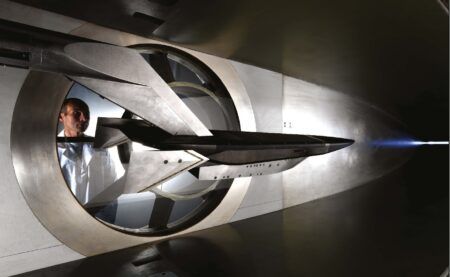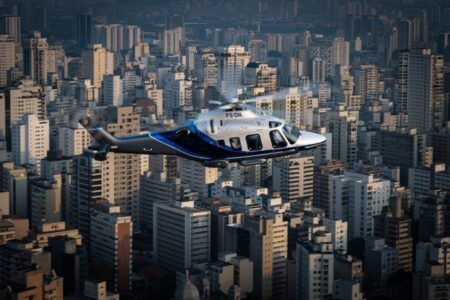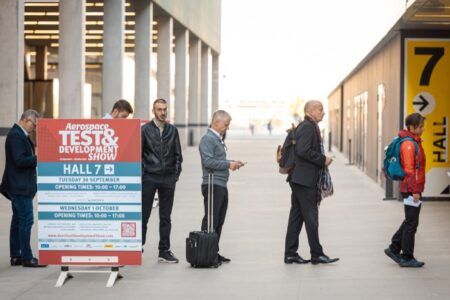The components and materials used in subsonic, supersonic and hypersonic aircraft tell a fascinating story about where we once were, where we currently are, and where we may yet go in the aerospace realm.
My book “Supersonic Effects on Rivets” is an investigation of the alloys used to make several components, including rivets and fasteners used in supersonic aircraft. Amongst other things, the book discusses the heat treatment of those alloys, materials selection, skin friction/drag effects, estimating temperature, thermal properties, and fatigue testing. Available via the QR code on this page, it features in-depth case studies on aircraft failures attributed to incorrect design and the failure of aerospace materials, as well as the lessons learnt from the failures of the Space Shuttle Columbia, American Airbus A300-600 Flight 587, and the iconic Concorde.
“Further research is needed in some areas to shed light on certain materials subjected to supersonic effects”
FASTER AT WHAT COST?
The incentive that Concorde afforded passengers was supersonic travel from one destination to another, in about half of the time it would take in a conventional aircraft. Essentially, passengers were in a time machine.
But Concorde did not usher in an age of supersonic travel. More than 20 years after its last flight, I am calling for engineers and scientists to collaborate better to develop a safer, environmentally friendlier, and more economical supersonic passenger aircraft than Concorde.
“Further research is needed in some areas to shed light on certain materials subjected to supersonic effects”
Although Concorde can provide more than just a stepping stone for future development of supersonic aircraft for everyday passengers, historical data through microscopic analysis of most materials on supersonic aircraft, including Concorde, have not been well characterized or well-documented, leading to a gap in the knowledge. This is because of either commercial sensitivities or because data in the field is still in its infancy and not well understood.
It is clear from my extensive literature review that the investigators assessing the wreckage and trying to ascertain information relating to materials in the Air France Concorde that crashed in 2000 found it exceedingly difficult to do so. Concorde was designed and constructed to travel at Mach 2.0, but the materials, technology, and environmental impact required to maintain this speed were different from what was conventionally available for subsonic and military aircraft. Ideally, further qualitative experimental research is needed in some areas to shed light on certain materials subjected to supersonic effects.
RIVET TESTING
A preliminary assessment in my review has been made for titanium rivets, which could be tested under conditions that simulate aerodynamic effects when the aircraft encounters speeds in excess of Mach 2.0. Furthermore, it is anticipated from future research that the data from the rivets would be generated in the laboratory.
For instance, wind tunnel experiments would be the basis for the aerodynamic investigation on titanium rivets, and from these experiments, an analysis should be carried out by sectioning the rivets and performing detailed microstructural evaluations. This would also help to determine whether a rivet’s strength varies with increasing time and temperatures during flight at supersonic speed.
Therefore, Vickers microhardness evaluation is also required so that if the rivet has aged further due to extra heating and time, a correlation can be made with overageing of the rivets. Certain empirical equations and methods of hardness testing on rivet sections are presented in the book to convert VHN to YS and UTS.
JOINING ISSUES
Whilst research in literature shows that ageing of certain aluminium alloys leads to increased tensile strength, there is a limit whereby the ageing time at a constant temperature or varied temperatures will affect the ageing kinetics, and in turn the strength of the alloy.
The skin of Concorde is made from the Hiduminium aluminium alloy, but the rivets are made from titanium alloy. The temperatures and duration during supersonic flight for both aluminium alloys and titanium alloys are not identical, nor are their mechanical properties.
The properties of titanium are far superior to those of aluminium alloys – this is the reason the use of aluminium alloys is restricted in Concorde. However, the variations in temperature, and pressurization/ depressurization of the cabin as well as stresses on the wings and fuselage also impact the performance of the titanium alloy rivets that hold many items together within the aircraft.

Amongst the myriad of materials used in Concorde, meticulous design and careful quality control for the construction of the aircraft would have ensured that materials far apart in the galvanic series are separated, or at the very least are insulated by some suitable protective means from one another. Also, knowledge of the Coefficient of Thermal Expansion (CTE) of the respective materials is imperative, as large differences would be detrimental to the structures, because they potentially create stresses, leading to eventual failure.
The use of the RR58 aluminium alloy skin would have been in contact with several other metals in Concorde. For instance, titanium alloy rivets or fasteners are in contact with RR58. Irrespective of any protective measures that would have been taken to insulate the materials from one another, when combined they would be subjected to a large difference in electrical potential (materials that are far apart in the galvanic series), thus placing them at high risk of corrosion.
“Small cracks were found in all seven of Concorde’s wings just one day before the Air France crash”
Therefore, if the rivets or fasteners are manufactured from titanium alloy (cathodic), and the skin is manufactured from aluminium alloy (anodic), then the ratio of anode to cathode is large, thereby reducing – not eliminating – the likelihood of corrosion.
Also, when titanium alloys and aluminium alloys are exposed to temperatures of between 20 – 200°C, which was typical in Concorde, then these alloys are predisposed to excessive thermal expansion differences.
Aluminium alloy 2618-T6 expands almost 2.5 times more than the titanium alloy Ti-6Al-4V alloy. Creep strain would also be experienced by such thermal expansion and stresses causing hairline cracks that lead to fatigue cracks, which ultimately cause the failure of that section.
FILLING IN KNOWLEDGE GAPS
It should be noted that small cracks were found in all seven of Concorde’s wings by British Airways just one day before the Air France crash. However, British Airways quashed the findings of these cracks as being of no major concern or consequence. There are no records or information in any literature that provide reasons as to why or how these cracks were caused.
The Air France Concorde crash was found to be caused by a titanium strip lying on the runway, but the accident was a major factor in why Concorde vanished from our skies three years later. Effectively, any major metallurgical issues that were present in Concorde vanished along with it.
The intention to systematically evaluate rivets experimentally as discussed in this book, would be primarily to both improve the understanding of aerodynamic heating on the rivets and to gain a better understanding of the effects of adjoining materials and structures connected with rivets. By improving the understanding of the material’s microstructural processes under supersonic conditions, it should be possible to understand further whether newer materials and processes can be developed to improve upon the limitations that have been experienced to date.
Ultimately, this research should provide more than just an advancement for further investigations on materials subjected to the effects of supersonic flight, and it should generate further attention and interest to narrow the knowledge gap in this field.
SUPERSONIC EFFECTS ON RIVETS, BY GEORGE NADIM MELHEM, PAUL RICHARD MUNROE AND AKSHAY VITHAL
The book provides background into subsonic aircraft, highlighting the various types of forces acting on them and presents case studies of composite failures leading to accidents and the lessons learnt in terms of design and materials selection. It then progresses to supersonic aircraft, including analysis of Concorde and how these aircraft can stretch during flight.
The book concludes by discussing the incentive in shortening travel time further and the impetus behind the selection of materials in Concorde. Validation behind the structural design for the engine, aircraft skin, and rivets is also presented in this chapter. Both active and future research is also presented.
The book will be useful for aerospace engineers involved in military and commercial aircraft, materials scientists and engineers, universities, colleges, higher education, schools and students. It is intended as a technical and niche resource in framing future designs of aerospace materials and the pivotal role that they play.
For more information and to buy the book click here!





